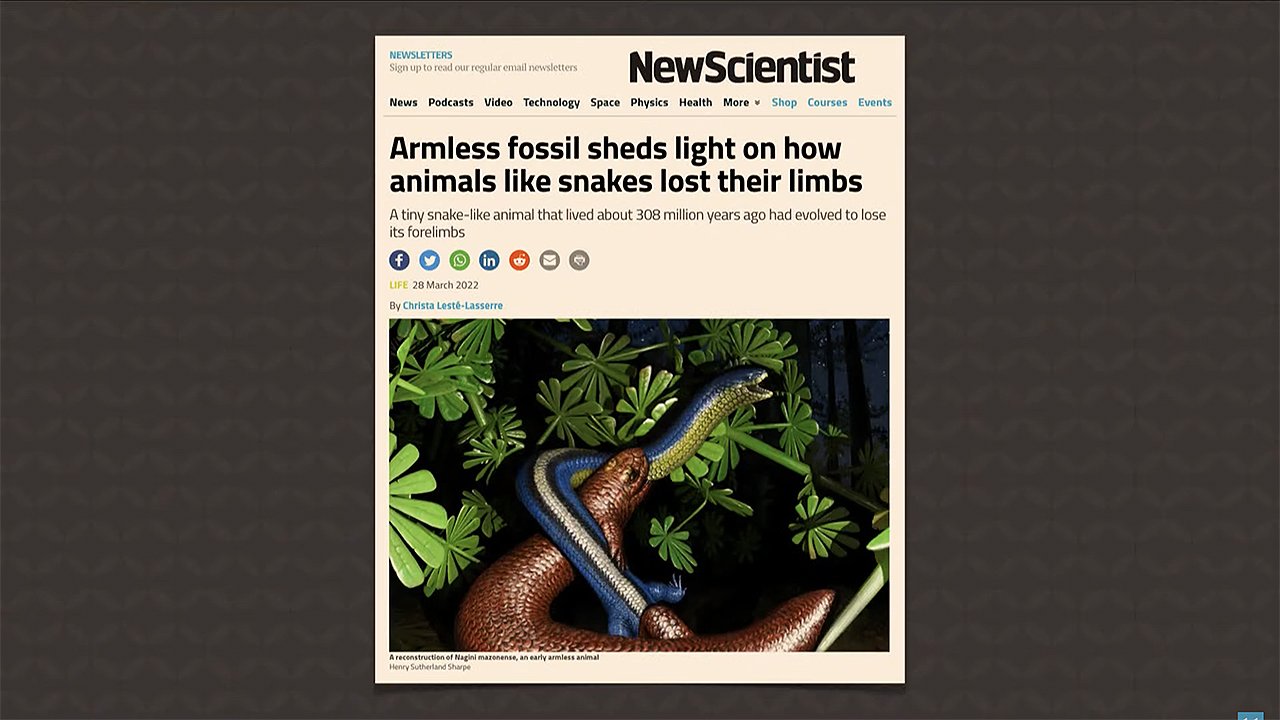
Does an Armless Fossil Shed Light on How Animals Like Snakes Lost Their Limbs?
I’ve used many words to describe evolution over the years, but I think I might have a new one which describes a recent fossil find: “disarming.” This pair of fossils (one of an adult specimen and one of a juvenile) of Nagini mazonense, a small snake-like animal (technically a molgophid recumbirostran) that supposedly lived about 308 million years ago, was discovered in the Francis Creek Shale of Illinois. The adult fossil specimen measures about 4 inches long (10 cm), and although it has reduced hind limbs, it has no pelvic girdle to support those limbs or front limbs. The more complete juvenile is around 2 inches (5 cm) long and also has no front limbs or pelvic girdle.
Now, the research journal that covered the fossil find constantly attributes this loss of genetic information as “evolution.” They point out that this fossil closely resembles how snakes and caecilians (legless amphibians) exhibit progressively reduced limbs before complete loss in their “evolutionary histories.” But today, there are living reptiles that have no arms but reduced hindlimbs (Pygopodidae—“armless” geckos and Chamaesaura—“grass lizards”). Maybe they just haven’t “evolved” enough yet!
The researchers described the proposed mechanisms behind limb loss in Nagini:
Although the mechanisms of limb reduction in many tetrapod lineages remain incompletely understood, it appears that limb reduction and loss can be accomplished by failures or disruptions to normal development during any of the three phases of limb development, resulting in a vast array of variation in limb-reduced phenotypes. Late phase disruptions to growth plate development, particularly the rate of longitudinal growth or timing of growth plate closure, are most common and typically lead to conditions where the majority of limb elements are retained but are reduced in overall size. Disruptions in limb morphogenesis and patterning during the limb bud phase will often result in loss of distinct limb modules, commonly the loss of entire digits but also the loss of other distal (but not proximal) elements, including carpals and/or tarsals. Failure in the earliest phase establishing the limb field is relatively rare but is the mechanism identified as resulting in the loss of the pectoral limb and girdle and associated musculature in caecilians and snakes and we suggest that this is the mechanism involved in forelimb loss in Nagini as well based on similarities in the pattern of limb loss (that is, complete lack of proximal appendicular elements and absence of a forelimb rudiment).
In other words, these are mutations in the developing reptile’s genes which disrupt its ability to grow limbs. (It is worth noting here that there is some debate among evolutionary biologists who differ on whether these recumbirostrans are reptiles or amphibians). This is a result of the curse (Genesis 3), not an evolutionary advancement. Or it may be that God designed these types of reptiles (or amphibians) as limbless or with reduced limbs originally (as part of the creeping things of Genesis 1:25).
Now to be sure, even in a cursed world, God allows some animals to adapt to their environment. And for burrowing or tree-dwelling animals, which many of the “legless lizards” are, not having limbs is not a detriment to their survival but may actually aid the animal.
Now to be sure, even in a cursed world, God allows some animals to adapt to their environment.
In any event, this is not molecules-to-man evolution but potentially a developmental mutation and the loss of information. Ironically, though, the researchers placed Nagini in a phylogenetic tree where both its ancestors and descendants are four-limbed recumbirostrans. How does this show an evolutionary developmental process in lizards or amphibians? It’s not just inconsistent: it’s totally disarming to their “story.”
Get More Answers on Answers News
This item was discussed today on Answers News with cohosts Dr. Georgia Purdom, Rob Webb, and Tim Chaffey. Answers News is our twice-weekly news program filmed live before a studio audience and broadcast on my Facebook page and the Answers in Genesis Facebook page. We also covered the following topics:
- Scientists discover when beetles became prolific.
- Atheist group pressures Tennessee town to remove cross display from mountain.
- Spiders use webs to extend their hearing.
- And more!
Be sure to join us each Monday and Wednesday at 2 p.m. (ET) on my Facebook page or the Answers in Genesis Facebook page for Answers News. You won’t want to miss this unique news program that gives science and culture news from a distinctly biblical and Christian perspective.
Thanks for stopping by and thanks for praying,
Ken
This item was written with the assistance of AiG’s research team.
Most Recent News
-
Dec. 18, 2025 from Ken Ham Blog
New data suggests IVF embryo deaths now exceed abortion totals, meaning abortion is no longer the leading cause of death in the US.
-
Dec. 15, 2025 from Ken Ham Blog
Are tomatoes “de-evolving” on the remote Galápagos islands?

Answers in Genesis is an apologetics ministry, dedicated to helping Christians defend their faith and proclaim the good news of Jesus Christ.
- Customer Service 800.778.3390
- Available Monday–Friday | 9 AM–5 PM ET
- © 2025 Answers in Genesis



